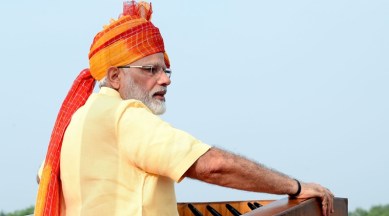Change in metrics a factor in infra boost under NDA
Since 2014-15, Railways has been measuring its achievements on the basis of how many kilometers of lines were “commissioned”, as opposed to how many kilometers were physically constructed during a particular financial year.

Prime Minister Narendra Modi in his I-Day speech mentioned how the pace of construction of highways and laying of railway lines has “doubled” in the past three years when compared with the UPA era.
In the case of Railways, it is true as per records. However, the NDA government uses a different metric than its predecessor, shifting the proverbial goalpost. Since 2014-15, Railways has been measuring its achievements on the basis of how many kilometers of lines were “commissioned”, as opposed to how many kilometers were physically constructed during a particular financial year.
Commissioning of a railway line traditionally meant that after the physical construction of the track is complete, it needed to be able to run trains commercially for it to be “commissioned”. This meant that the Commissioner of Railway Safety would have given a safety certificate for passenger trains to run on the line. Running of freight trains does not require any safety certificate.
Moreover, if a project of 100-km of railway line typically takes about five years to build, it is only in the final year that the whole 100 km is commissioned and thrown open. For example, even though in the final year the actual construction of that line is just a small part of 100 kilometers, books would show that 100 km of line was commissioned that year, although the credit for actually constructing all the 100 kilometers is spread over the past five years– often falling in the time of the previous government.
Since 2014-15, railways only discloses how many kilometers were commissioned. And in that year, majority of the lines commissioned were not fit for passenger operations, but only for freight trains. It commissioned 1,983 km in 2014-15 and a 2,828 km in 2015-16 by way of new lines, gauge conversion and doubling of tracks.
In comparison, between 2004 and 2009 the UPA regime had seen commissioning of 1,477 km per year and 1,528 km between 2009 and 2014. In 2016-17, the picture improved substantially, as a large number of commissioning of lines also included running of passenger trains, which meant a nod of the safety regulator. That year, it commissioned 2,857 km, marginally higher than the previous year.
In 2015-16, a large amount, at least a quarter of the money shows as spent on Capital expenditure for creation of infrastructure assets, was actually advance payments for works to be done in the subsequent year — but shown as money spent in the current year, as per accounting technicality. As far as highways is concerned, the emphasis is on the metric of how many kilometers worth of highway contracts has been awarded.
Between 2011 and 2014, 14,879 km of works were awarded. But between 2014 and 2017, that figure stood at a total of 34,018 km — more than double. The government however, talks less about how many kilometers worth of projects were completed and highlights kilometers built per day. During the NDA regime, the pace has been between 21-25 km per day, more than double of what it was during the UPA regime. The target is somewhere around 41 km per day, however officials concede that it has been kept steep to maintain the pressure of delivery. By March 2014, the country had 91,287 km of highways. That by April 2017 swelled to 1,14,158 kilometers.
Health Infrastructure
Modi got it almost right when he said that 350-400 dialysis centres were in place in as many districts. At present there are 330 district dialysis centres run on PPP mode that have so far completed 17 lakh sessions. Under the scheme states negotiate with private providers for a pay-by-sitting basis. While the rates differ from state to state it is usually in the Rs 900-1200 range.
According to the health ministry, every year about 2.2 lakh new patients of End Stage Renal Disease are added, resulting in demand for 3.4 crore dialysis sittings. With about 4,950 private dialysis centres— that charge between Rs 1,000-3,000 per sitting per patient — the demand is less than half met by the existing infrastructure. A patient requires about 150 sittings of dialysis every year.